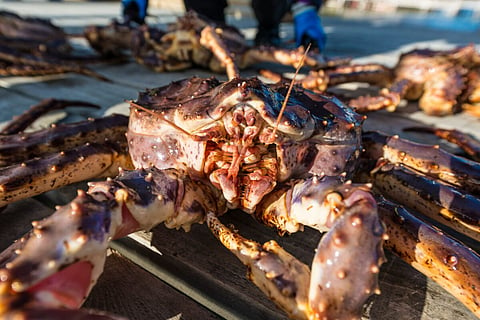

King crab caught in Norwegian waters.
Photo: Adobe Stock.
Last week, the Norwegian Institute of Marine Research published its recommendation on the king crab catch quota for 2026. Following this year's stock assessment, the Norwegian researchers recommend a 44% year-on-year cut in the quota, as the harvestable stock has decreased. This is an important consideration given that this species is increasingly significant for Norwegian seafood exports to the U.S.
In the same report, the Norwegian Institute of Marine Research noted that king crab is an introduced species in Norwegian waters and is therefore managed according to a dual objective: limiting fishing in East Finnmark, while allowing open fishing in the West of North Cape to keep populations as low as possible.
However, despite being an introduced species, the king crab is gaining importance in Norwegian seafood exports, especially to the United States, so, as said, its availability next year could be significant for the trade balance of the fishing industry in Norway.
In August this year, for example, while U.S. tariffs ended up affecting Norwegian salmon exports, Norwegian king crab followed the opposite trend. Even with a 10% decrease in volume, value increased by 16%; there was higher demand, higher prices, and the U.S. was the largest destination market.
As Josefine Voraa, head of shellfish at the Norwegian Seafood Council, then explained, following the sanctions against Russian crab in the United States in 2022, Russia has shifted more of its live crab exports towards Asia and started fishing earlier.
This has pushed down prices for live crab in Asia, but, at the same time, the absence of Russian crab in the U.S. has created a shortage and increased demand for frozen red king crab from Norway, resulting in high prices and, above all, greater demand for frozen Norwegian products, which took over live Russian crab that month.
The trend continued in September, when Norwegian king crab exports to the United States increased by 59% in value and 27% in volume compared to the previous year. For frozen king crab, volume growth was 81% compared to September 2024, with a 26% increase in the average export price.
Meanwhile, in October, although the decline in catches caused a 21% drop in volume, the decline in value was only 2% year-on-year, and last month, the United States remained the largest market for Norwegian king crab.
"The U.S. is still the largest market for frozen king crab, even though the Alaskan red king crab season started in October," explained Josefine Voraa.
Now, it remains to be seen how Norwegian fisheries authorities will implement the Norwegian Institute of Marine Research's recommendation to cut the king crab quota by 44% and whether catches outside the quota-regulated area will be sufficient to compensate for this increase in demand.
